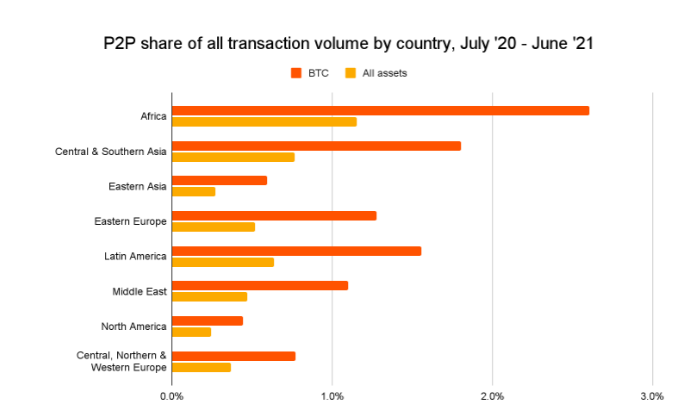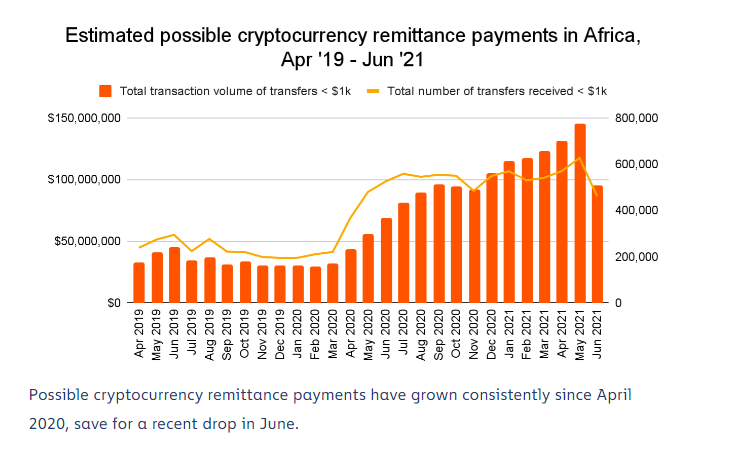
The cost incurred by African migrants or expatriates when sending funds via the so-called formal corridors remains way above the UN target of less than three percent, the latest data from the World Bank has shown. On the other hand, the cost is much lower than the target when cryptocurrencies are used.
Global average above SDG target
According to the latest data on remittances from the World Bank (WB), Sub-Saharan Africa has once again emerged as the most expensive region to send remittances to. With an average cost of 7.8% for every $200 sent, the region, which received $49 billion in remittances in 2021, improved the 2020 figure by just 0.4%.
Nigeria, which accounts for the largest chunk of the region’s remittances, saw its inflows go up by 11.2 percent. According to the WB, the growth in the value of remittances sent to Nigeria via formal channels can be attributed to the country’s policies which encourage recipients to cash out at regulated platforms. Other countries from the region that saw significant growth in their inflows include Cabo Verde, whose incoming remittances rose by 23.3%, Gambia (31%), and Kenya (20.1%).
Globally, the average cost of cross-border remittances was 6% over the same period. According to the World Bank, Sub-Saharan Africa and global average transaction costs are still well above Sustainable Development Goal (SDG) 10.3 by less than 3%.
Yet, despite the ongoing efforts to lower this figure, the cost of moving funds across borders simply remains high and has been for years. This implies that the goal to attain the United Nations SDG 10.3 target of reducing the transaction costs of migrant remittances to less than 3% by 2030 is unlikely to be achieved. Similarly, the UN’s mission of eliminating remittance corridors with costs higher than 5 percent appears unattainable.
Why migrants are turning to crypto
Meanwhile, the high cost of sending remittances through formal channels and the rigorous KYC standards that come with them often force migrants to seek out more convenient and less cumbersome channels. Couriers, cross-border trucks or bus drivers are some of the informal ways migrants use to send remittances to loved ones. However, these informal methods have their own challenges, the main one being security of funds.
So while cryptocurrencies were not initially created to solve this dilemma, their growing use by migrants remitting money to their loved ones shows that they can be part of the solution. As the 2021 Geography of Cryptocurrency report by the blockchain intelligence firm Chainalysis will attest, a growing number of African migrants could now be using peer-to-peer crypto exchange platforms when sending funds back home.

To illustrate, data from the intelligence firm suggests that between July 2020 and June 2021, a total of $105.6 billion worth of cryptocurrency was sent to recipients on the African continent. Of this total, transfers between regions accounted for almost 96%.
The number of incoming transfers that are below $1,000 is the other metric used in the report, which again supports the assertion that African migrants are using digital currencies to remit funds. According to Chainalysis, the number of such transfers went past the 200,000 mark for the first time in May 2020 and has stayed above this level since. In fact, by May 2021, the number of transfers below $1,000 was just under 800,000.

In addition to being a faster and possibly more secure way to send funds, cryptocurrencies are significantly cheaper compared to so-called formal channels. Although it can cost up to $10 (10%) to move $100 from South Africa to Zimbabwe using regular lanes, it costs around $0.01 to send $200 through the BCH network or less than 1%, for example. It even costs much less than a penny to transfer the same value to the Stellar network. Besides these two examples, there are several other examples that prove that cryptocurrencies can be a better alternative to regular money transfer channels.
Regulators Must Not Curtail the Use of Functional Innovation
Therefore, while critics — particularly those based in advanced economies — are eager to highlight the flaws in cryptocurrencies, migrants from not only from Africa but across the globe are proving that cryptos are better than traditional channels. If cryptocurrencies were suddenly to become the widely used means of transferring funds across different jurisdictions, then the attainment of the SDG 10.3 goal of achieving remittance costs lower than three percent could happen well before the 2030 deadline.
It therefore stands to reason that regulators should be guided more by facts and not malice when dealing with cryptocurrencies. Regulation of cryptocurrencies should not be about restricting their use as the United Nations Conference on Trade and Development (UNCTAD) recommended in a recent policy brief.
Instead, regulators should promote or encourage the increased use of cryptocurrencies where they are proving to be useful. An innovation that emancipates the poor or one that attempts to level the playing field should be protected and not ostracized.


















